Hashemi Shamali: A hidden open-air museum
By Zane Wolfang, Jordan News
last updated: Jan 17,2022

Our cab dropped us off in front of a supermarket on
Al-Bathaa Street, and we sort of lingered there on the sidewalk, unsure of
where to meet Underground Amman for the vaguely defined tour we had seen
advertised on Instagram. Thankfully, the market employee sweeping the sidewalk
knew exactly what two confused foreigners were looking for in Hashemi Shamali
on a sunny Saturday morning. He kindly directed us around the corner, wishing
us well and giving no hint that we were about to have our minds completely
blown.
Our reward for leaving the comfortable confines of Jabal Luweibdeh, the trendy area where we and most of our fellow foreigners on the
tour pay horribly overpriced rent for the privilege of living in some of
Amman’s oldest houses, was finding out that Hasehmi Shamali, an east Amman
neighborhood home to a large community of Palestinian refugees, is also the
birthplace of one of the most extraordinary street art scenes in the world. The
whole neighborhood is an open air museum, a street-level exhibition of a
decade’s worth of spectacular murals painted by both local and international
artists.
Our guide for the day was Alaeddin Rahmeh, an Amman hip-hop
head who traces his heritage to the Palestinian city of Yaffa. Rahmeh, who
breakdances when he is not regaling tourists with tales from his archival
memory of Jordanian hip-hop during Underground Amman tours, who voices his
enthusiasm for anything that jives with his hip-hop ethos with an exclaimed
“Fresh!” and dresses accordingly.
His outfit on Saturday consisted of a flat brim hat with the
Underground Amman logo embroidered in calligraphy, a retro black, purple and
green-striped windbreaker and, to my envy after a late Friday night, a steaming
hot cup of coffee which I have since learned is an almost ubiquitous detail of
his daily composition.
(Photo: Maggie Masse)
Rahmeh’s dad is an imam, and he describes his family, like
many in the working class Jabal Al-Nuzha neighborhood where he grew up, as
somewhat conservative. That did not stop him and his friends from learning how
to breakdance back in the early 2000s, and then how to rap and make beats and
write graffiti. He proudly estimates that over half of Amman’s early 2000s
hip-hop crowd got their start in Jabal Al-Nuzha, although he explained with
equal pride that the scene is quite diverse and inclusive, with Jordanians,
Palestinians, Iraqis, Armenians, Syrians and others all participating in a
strong and collaborative community.
Framed by one of the neighborhood’s earliest murals, a huge
portrait of a refugee girl from Azraq rocking a Mickey Mouse hoodie, he said he
was eternally transformed at 14 after happening to see a group of New York
b-boys headspinning on a nightly news segment, then secretly watching a VHS
tape of German breakdancers brought by a friend from Dubai, then starting to
find kids from other neighborhoods who shared his passion for hip-hop who all
got together to research the genre in depth with the rise of Jordan’s earliest
internet cafés back around 2005.
(Photo: Maggie Masse)
In between breakdancing, beatboxing, dabbling in graffiti
and spitting Arabic freestyles with some of the best rappers in Amman, he has
been collecting and telling stories about the city’s vibrant hip-hop, graffiti
and street art scenes for years. Eventually, he and his wife Hannah decided to
start Underground Amman and let the tourists in on the secret.
Rahmeh was accompanied on the tour by Suhaib Attar, a local
painter whose modesty and quiet demeanor belie the fact that he is one of the
coolest graffiti and mural artists on the planet. Attar is now a world-renowned
artist, but he started as a scrappy Palestinian kid born and raised in Hashemi
Shamali, walking to school and dreaming about filling the walls of his
neighborhood’s drab government housing with beautiful art.
(Photo: Maggie Masse)
Attar started with graffiti, but eventually felt limited. He
started learning street art techniques from Kut, an older head who was part of
a German duo called Herakut, and he now paints with over 25 different techniques.
He started to act on his childhood dream, inviting artists
to his neighborhood, hosting them and storing their supplies in his family home
for free, and they operated by the “better to ask for forgiveness than
permission” model. But after the first three murals, including the one
mentioned above, which he did in collaboration with Brisbane-born street art
legend Fintan Magee after they worked together on an art education project with
refugee orphans in Azraq, they got the full green light from the Amman
municipality. The partnership with the municipality, which has strengthened and
solidified over the years, made Jordan one of the first countries in the world
to legalize and celebrate street art and graffiti.
(Photo: Maggie Masse)
More importantly than the local government, the artists won
the trust and support of the local community. Now the neighborhood is an open
canvas for any artist, although the locals will still paint over murals they do
not approve of or simply do not care for.
It is clear that staying connected with the community where
he grew up and where his family still lives is important to Attar; at one
point, while he was explaining some of the techniques the artists use to paint
such huge pieces, he paused to greet some older ladies who were walking home from
the market, chatting and laughing with them and accepting a fresh piece of
falafel when it was offered. Later, I chatted with some young boys, probably
about 11 years old, who were trailing behind our tour and had mustered the
courage to shout “hello” at us. I asked them if they were from the
neighborhood, and they told me no, they were from Palestine. Sumud for days.
They seemed equally curious about the art and the foreigners who had come to
gawk at it in a neighborhood that does not get much tourist traffic, and were
eager to help once they understood why we were there, pointing back toward the
way we came and explaining that there was still more art to be discovered in
the alleys.
(Photo: Maggie Masse)
They were also intrigued to learn that it was a kid just
like them who had started the entire project and painted some of its most
magnificent pieces.
Attar’s childhood neighborhood is built in a roughly
triangular shape, with each building offset slightly from the previous, so as
you walk southeast from the westernmost point of the triangle where the tour
starts, you see the murals in series on the western face of each building, each
one emerging from behind the last. Many of the murals are products of the
Baladk Street Art Festival, which has been bringing regional and international
artists to Amman to collaborate on murals around the city since 2012, and in
between them, on the southern faces of the first three buildings, is a massive
three-part Arabic calligraphy installation (a street art style which has been
dubbed “calligraffiti” by the local artists) with the words “Art/is/the
environment.”
It is a beautiful message, and in Hashemi Shamali, it is
also a very literal statement. Once you enter the interior of the neighborhood,
which is built like a maze, the murals start to surprise you, with vibrant
colors and vivid images seeming to appear in every nook and pop out around
every corner.
Some of the artists who came to collaborate on large murals
for Baladk over the years have made it a point to secretly paint smaller murals
for the community in random, sometimes hidden, places – Attar laughed as he
pointed out one which a Baladk-commissioned artist had done without telling
anybody, and explained that it took him a few days of searching to locate it
after seeing pictures of it start to pop up on social media.
Underground Amman, which also offers a second street art
tour covering the areas of Jabal Amman, Downtown, and Jabal Luweibdeh, is folded
into a larger venture called Tales of Jordan, which works on a variety of
interesting projects in collaboration with the local hip-hop community,
including a monthly “hip-hop as high art” jam called Zajal, in partnership with
the Jordanian National Gallery of Fine Arts. Fresh indeed.
(Photo: Maggie Masse)
Rahmeh was an excellent guide, providing a detailed and
entertaining history of the art we were looking at, contextualizing it well,
and gracefully calling upon Attar at key junctures to explain more technical
elements of the painting process and more specific anecdotes of the local
history surrounding its development. Attar was also superb, equal parts
knowledgeable and humble, constantly giving credit to the people who mentored
him and the local community which supported his vision, and speaking
passionately about his efforts to increase access to the arts for refugees and
children.
For the price of a modest donation, the two of them gave a
brilliant tour of Hashemi Shamali’s open air street art museum, billed as the
best-kept secret in Amman – until now.
Read more Culture and Arts
(window.globalAmlAds = window.globalAmlAds || []).push('admixer_async_509089081')
(window.globalAmlAds = window.globalAmlAds || []).push('admixer_async_552628228')
Read More
"Pray for Me" - Mohamed Sami Announces Retirement from TV Drama Directing
Eagle Films Settles the Controversy Over Allegations of Stealing the Idea of "Bil-Dam"
Syria's Slaaf Fawakhri Supports Jamal Suleiman After Sectarian Accusations
Our cab dropped us off in front of a supermarket on
Al-Bathaa Street, and we sort of lingered there on the sidewalk, unsure of
where to meet Underground Amman for the vaguely defined tour we had seen
advertised on Instagram. Thankfully, the market employee sweeping the sidewalk
knew exactly what two confused foreigners were looking for in Hashemi Shamali
on a sunny Saturday morning. He kindly directed us around the corner, wishing
us well and giving no hint that we were about to have our minds completely
blown.
Our reward for leaving the comfortable confines of Jabal Luweibdeh, the trendy area where we and most of our fellow foreigners on the tour pay horribly overpriced rent for the privilege of living in some of Amman’s oldest houses, was finding out that Hasehmi Shamali, an east Amman neighborhood home to a large community of Palestinian refugees, is also the birthplace of one of the most extraordinary street art scenes in the world. The whole neighborhood is an open air museum, a street-level exhibition of a decade’s worth of spectacular murals painted by both local and international artists.
Our guide for the day was Alaeddin Rahmeh, an Amman hip-hop head who traces his heritage to the Palestinian city of Yaffa. Rahmeh, who breakdances when he is not regaling tourists with tales from his archival memory of Jordanian hip-hop during Underground Amman tours, who voices his enthusiasm for anything that jives with his hip-hop ethos with an exclaimed “Fresh!” and dresses accordingly.
His outfit on Saturday consisted of a flat brim hat with the Underground Amman logo embroidered in calligraphy, a retro black, purple and green-striped windbreaker and, to my envy after a late Friday night, a steaming hot cup of coffee which I have since learned is an almost ubiquitous detail of his daily composition.
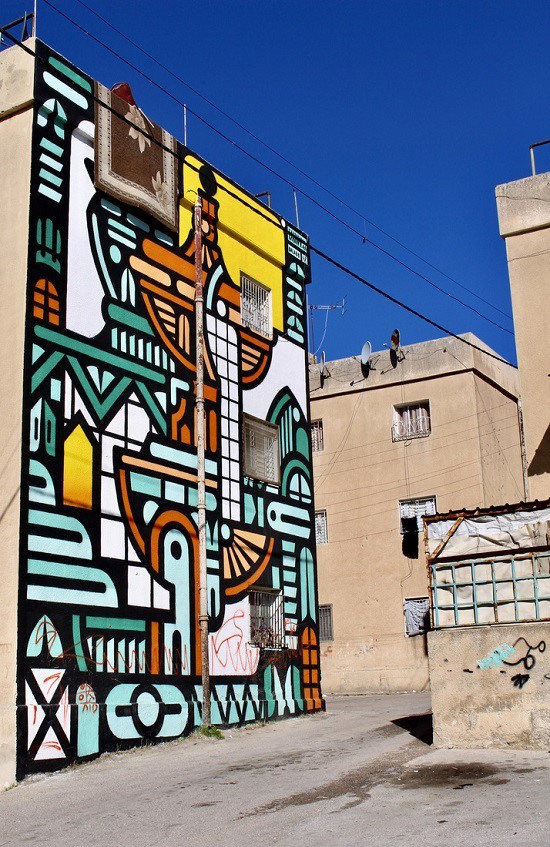
(Photo: Maggie Masse)
Rahmeh’s dad is an imam, and he describes his family, like many in the working class Jabal Al-Nuzha neighborhood where he grew up, as somewhat conservative. That did not stop him and his friends from learning how to breakdance back in the early 2000s, and then how to rap and make beats and write graffiti. He proudly estimates that over half of Amman’s early 2000s hip-hop crowd got their start in Jabal Al-Nuzha, although he explained with equal pride that the scene is quite diverse and inclusive, with Jordanians, Palestinians, Iraqis, Armenians, Syrians and others all participating in a strong and collaborative community.
Framed by one of the neighborhood’s earliest murals, a huge portrait of a refugee girl from Azraq rocking a Mickey Mouse hoodie, he said he was eternally transformed at 14 after happening to see a group of New York b-boys headspinning on a nightly news segment, then secretly watching a VHS tape of German breakdancers brought by a friend from Dubai, then starting to find kids from other neighborhoods who shared his passion for hip-hop who all got together to research the genre in depth with the rise of Jordan’s earliest internet cafés back around 2005.
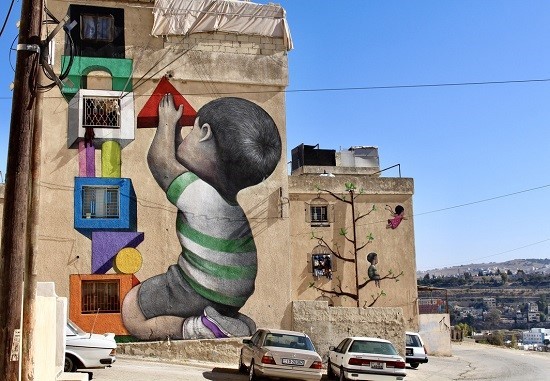
(Photo: Maggie Masse)
In between breakdancing, beatboxing, dabbling in graffiti and spitting Arabic freestyles with some of the best rappers in Amman, he has been collecting and telling stories about the city’s vibrant hip-hop, graffiti and street art scenes for years. Eventually, he and his wife Hannah decided to start Underground Amman and let the tourists in on the secret.
Rahmeh was accompanied on the tour by Suhaib Attar, a local painter whose modesty and quiet demeanor belie the fact that he is one of the coolest graffiti and mural artists on the planet. Attar is now a world-renowned artist, but he started as a scrappy Palestinian kid born and raised in Hashemi Shamali, walking to school and dreaming about filling the walls of his neighborhood’s drab government housing with beautiful art.
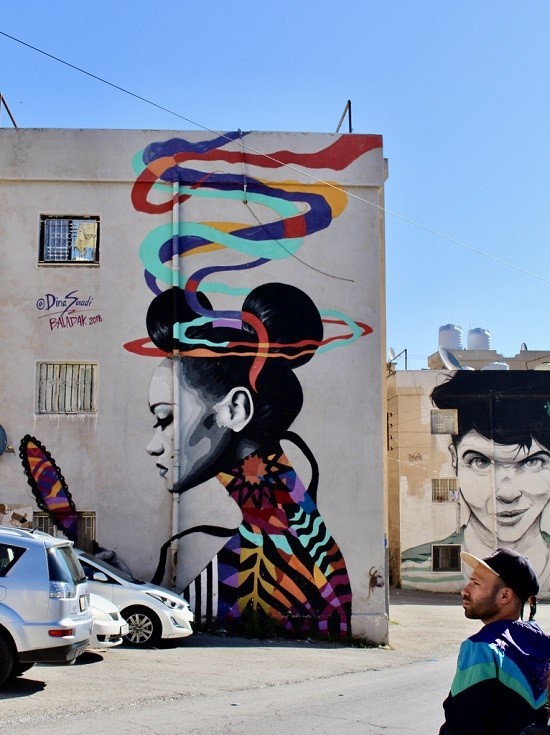
(Photo: Maggie Masse)
Attar started with graffiti, but eventually felt limited. He started learning street art techniques from Kut, an older head who was part of a German duo called Herakut, and he now paints with over 25 different techniques.
He started to act on his childhood dream, inviting artists to his neighborhood, hosting them and storing their supplies in his family home for free, and they operated by the “better to ask for forgiveness than permission” model. But after the first three murals, including the one mentioned above, which he did in collaboration with Brisbane-born street art legend Fintan Magee after they worked together on an art education project with refugee orphans in Azraq, they got the full green light from the Amman municipality. The partnership with the municipality, which has strengthened and solidified over the years, made Jordan one of the first countries in the world to legalize and celebrate street art and graffiti.
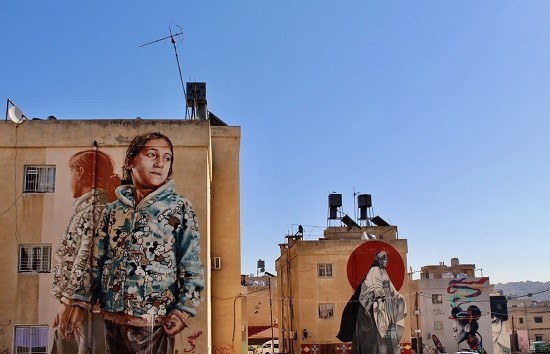
(Photo: Maggie Masse)
More importantly than the local government, the artists won the trust and support of the local community. Now the neighborhood is an open canvas for any artist, although the locals will still paint over murals they do not approve of or simply do not care for.
It is clear that staying connected with the community where he grew up and where his family still lives is important to Attar; at one point, while he was explaining some of the techniques the artists use to paint such huge pieces, he paused to greet some older ladies who were walking home from the market, chatting and laughing with them and accepting a fresh piece of falafel when it was offered. Later, I chatted with some young boys, probably about 11 years old, who were trailing behind our tour and had mustered the courage to shout “hello” at us. I asked them if they were from the neighborhood, and they told me no, they were from Palestine. Sumud for days. They seemed equally curious about the art and the foreigners who had come to gawk at it in a neighborhood that does not get much tourist traffic, and were eager to help once they understood why we were there, pointing back toward the way we came and explaining that there was still more art to be discovered in the alleys.
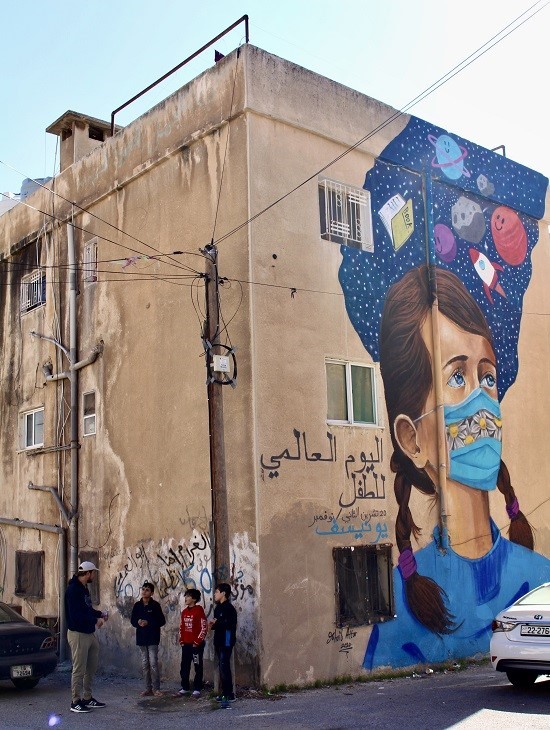
(Photo: Maggie Masse)
They were also intrigued to learn that it was a kid just like them who had started the entire project and painted some of its most magnificent pieces.
Attar’s childhood neighborhood is built in a roughly triangular shape, with each building offset slightly from the previous, so as you walk southeast from the westernmost point of the triangle where the tour starts, you see the murals in series on the western face of each building, each one emerging from behind the last. Many of the murals are products of the Baladk Street Art Festival, which has been bringing regional and international artists to Amman to collaborate on murals around the city since 2012, and in between them, on the southern faces of the first three buildings, is a massive three-part Arabic calligraphy installation (a street art style which has been dubbed “calligraffiti” by the local artists) with the words “Art/is/the environment.”
It is a beautiful message, and in Hashemi Shamali, it is also a very literal statement. Once you enter the interior of the neighborhood, which is built like a maze, the murals start to surprise you, with vibrant colors and vivid images seeming to appear in every nook and pop out around every corner.
Some of the artists who came to collaborate on large murals for Baladk over the years have made it a point to secretly paint smaller murals for the community in random, sometimes hidden, places – Attar laughed as he pointed out one which a Baladk-commissioned artist had done without telling anybody, and explained that it took him a few days of searching to locate it after seeing pictures of it start to pop up on social media.
Underground Amman, which also offers a second street art tour covering the areas of Jabal Amman, Downtown, and Jabal Luweibdeh, is folded into a larger venture called Tales of Jordan, which works on a variety of interesting projects in collaboration with the local hip-hop community, including a monthly “hip-hop as high art” jam called Zajal, in partnership with the Jordanian National Gallery of Fine Arts. Fresh indeed.
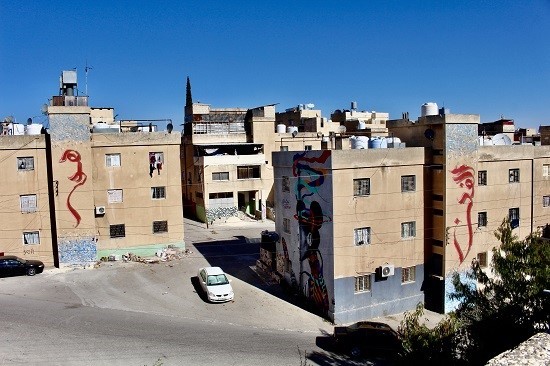
(Photo: Maggie Masse)
Rahmeh was an excellent guide, providing a detailed and entertaining history of the art we were looking at, contextualizing it well, and gracefully calling upon Attar at key junctures to explain more technical elements of the painting process and more specific anecdotes of the local history surrounding its development. Attar was also superb, equal parts knowledgeable and humble, constantly giving credit to the people who mentored him and the local community which supported his vision, and speaking passionately about his efforts to increase access to the arts for refugees and children.
For the price of a modest donation, the two of them gave a brilliant tour of Hashemi Shamali’s open air street art museum, billed as the best-kept secret in Amman – until now.
Read more Culture and Arts
Our reward for leaving the comfortable confines of Jabal Luweibdeh, the trendy area where we and most of our fellow foreigners on the tour pay horribly overpriced rent for the privilege of living in some of Amman’s oldest houses, was finding out that Hasehmi Shamali, an east Amman neighborhood home to a large community of Palestinian refugees, is also the birthplace of one of the most extraordinary street art scenes in the world. The whole neighborhood is an open air museum, a street-level exhibition of a decade’s worth of spectacular murals painted by both local and international artists.
Our guide for the day was Alaeddin Rahmeh, an Amman hip-hop head who traces his heritage to the Palestinian city of Yaffa. Rahmeh, who breakdances when he is not regaling tourists with tales from his archival memory of Jordanian hip-hop during Underground Amman tours, who voices his enthusiasm for anything that jives with his hip-hop ethos with an exclaimed “Fresh!” and dresses accordingly.
His outfit on Saturday consisted of a flat brim hat with the Underground Amman logo embroidered in calligraphy, a retro black, purple and green-striped windbreaker and, to my envy after a late Friday night, a steaming hot cup of coffee which I have since learned is an almost ubiquitous detail of his daily composition.

(Photo: Maggie Masse)
Rahmeh’s dad is an imam, and he describes his family, like many in the working class Jabal Al-Nuzha neighborhood where he grew up, as somewhat conservative. That did not stop him and his friends from learning how to breakdance back in the early 2000s, and then how to rap and make beats and write graffiti. He proudly estimates that over half of Amman’s early 2000s hip-hop crowd got their start in Jabal Al-Nuzha, although he explained with equal pride that the scene is quite diverse and inclusive, with Jordanians, Palestinians, Iraqis, Armenians, Syrians and others all participating in a strong and collaborative community.
Framed by one of the neighborhood’s earliest murals, a huge portrait of a refugee girl from Azraq rocking a Mickey Mouse hoodie, he said he was eternally transformed at 14 after happening to see a group of New York b-boys headspinning on a nightly news segment, then secretly watching a VHS tape of German breakdancers brought by a friend from Dubai, then starting to find kids from other neighborhoods who shared his passion for hip-hop who all got together to research the genre in depth with the rise of Jordan’s earliest internet cafés back around 2005.

(Photo: Maggie Masse)
In between breakdancing, beatboxing, dabbling in graffiti and spitting Arabic freestyles with some of the best rappers in Amman, he has been collecting and telling stories about the city’s vibrant hip-hop, graffiti and street art scenes for years. Eventually, he and his wife Hannah decided to start Underground Amman and let the tourists in on the secret.
Rahmeh was accompanied on the tour by Suhaib Attar, a local painter whose modesty and quiet demeanor belie the fact that he is one of the coolest graffiti and mural artists on the planet. Attar is now a world-renowned artist, but he started as a scrappy Palestinian kid born and raised in Hashemi Shamali, walking to school and dreaming about filling the walls of his neighborhood’s drab government housing with beautiful art.

(Photo: Maggie Masse)
Attar started with graffiti, but eventually felt limited. He started learning street art techniques from Kut, an older head who was part of a German duo called Herakut, and he now paints with over 25 different techniques.
He started to act on his childhood dream, inviting artists to his neighborhood, hosting them and storing their supplies in his family home for free, and they operated by the “better to ask for forgiveness than permission” model. But after the first three murals, including the one mentioned above, which he did in collaboration with Brisbane-born street art legend Fintan Magee after they worked together on an art education project with refugee orphans in Azraq, they got the full green light from the Amman municipality. The partnership with the municipality, which has strengthened and solidified over the years, made Jordan one of the first countries in the world to legalize and celebrate street art and graffiti.

(Photo: Maggie Masse)
More importantly than the local government, the artists won the trust and support of the local community. Now the neighborhood is an open canvas for any artist, although the locals will still paint over murals they do not approve of or simply do not care for.
It is clear that staying connected with the community where he grew up and where his family still lives is important to Attar; at one point, while he was explaining some of the techniques the artists use to paint such huge pieces, he paused to greet some older ladies who were walking home from the market, chatting and laughing with them and accepting a fresh piece of falafel when it was offered. Later, I chatted with some young boys, probably about 11 years old, who were trailing behind our tour and had mustered the courage to shout “hello” at us. I asked them if they were from the neighborhood, and they told me no, they were from Palestine. Sumud for days. They seemed equally curious about the art and the foreigners who had come to gawk at it in a neighborhood that does not get much tourist traffic, and were eager to help once they understood why we were there, pointing back toward the way we came and explaining that there was still more art to be discovered in the alleys.

(Photo: Maggie Masse)
They were also intrigued to learn that it was a kid just like them who had started the entire project and painted some of its most magnificent pieces.
Attar’s childhood neighborhood is built in a roughly triangular shape, with each building offset slightly from the previous, so as you walk southeast from the westernmost point of the triangle where the tour starts, you see the murals in series on the western face of each building, each one emerging from behind the last. Many of the murals are products of the Baladk Street Art Festival, which has been bringing regional and international artists to Amman to collaborate on murals around the city since 2012, and in between them, on the southern faces of the first three buildings, is a massive three-part Arabic calligraphy installation (a street art style which has been dubbed “calligraffiti” by the local artists) with the words “Art/is/the environment.”
It is a beautiful message, and in Hashemi Shamali, it is also a very literal statement. Once you enter the interior of the neighborhood, which is built like a maze, the murals start to surprise you, with vibrant colors and vivid images seeming to appear in every nook and pop out around every corner.
Some of the artists who came to collaborate on large murals for Baladk over the years have made it a point to secretly paint smaller murals for the community in random, sometimes hidden, places – Attar laughed as he pointed out one which a Baladk-commissioned artist had done without telling anybody, and explained that it took him a few days of searching to locate it after seeing pictures of it start to pop up on social media.
Underground Amman, which also offers a second street art tour covering the areas of Jabal Amman, Downtown, and Jabal Luweibdeh, is folded into a larger venture called Tales of Jordan, which works on a variety of interesting projects in collaboration with the local hip-hop community, including a monthly “hip-hop as high art” jam called Zajal, in partnership with the Jordanian National Gallery of Fine Arts. Fresh indeed.

(Photo: Maggie Masse)
Rahmeh was an excellent guide, providing a detailed and entertaining history of the art we were looking at, contextualizing it well, and gracefully calling upon Attar at key junctures to explain more technical elements of the painting process and more specific anecdotes of the local history surrounding its development. Attar was also superb, equal parts knowledgeable and humble, constantly giving credit to the people who mentored him and the local community which supported his vision, and speaking passionately about his efforts to increase access to the arts for refugees and children.
For the price of a modest donation, the two of them gave a brilliant tour of Hashemi Shamali’s open air street art museum, billed as the best-kept secret in Amman – until now.
Read more Culture and Arts


